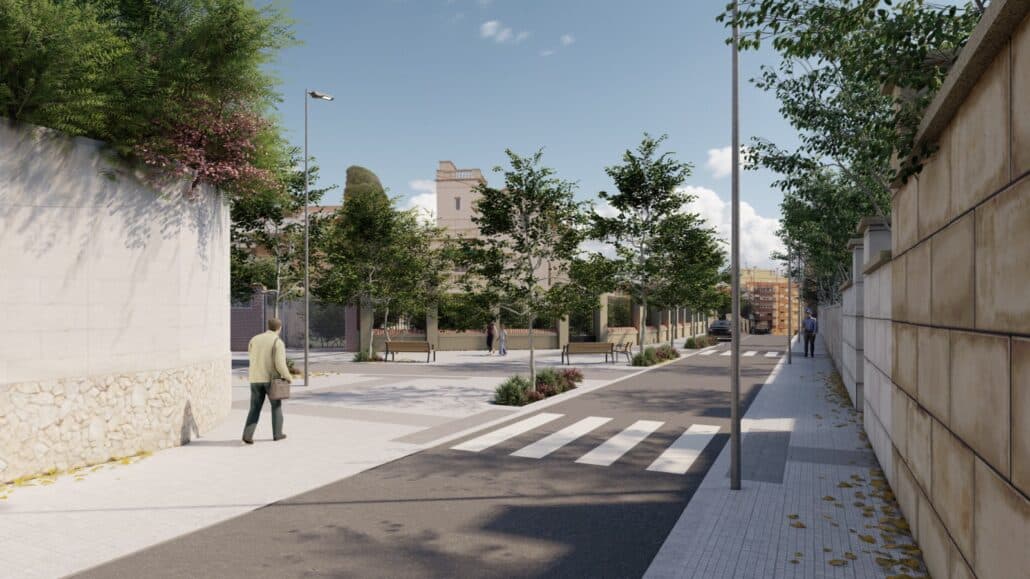Barcelona City Council has launched an ambitious renovation plan in the Can Baró neighborhood, focusing on carrers Albert Llanas and Miquel dels Sants Oliver. This intervention, which has a total budget of 2.52 million euros, promises to change the face of these two streets, with a focus on accessibility, safety and sustainability. The project will be partially financed through the Pla de Barris de Can Baró, as well as with revenue from the social return of Park Güell. With an expected duration of 16 months, this effort seeks to solve infrastructure problems, improve pedestrian mobility and optimize public space.
 A necessary project for the neighborhood
A necessary project for the neighborhood
The current state of Albert Llanas and Miquel dels Sants Oliver streets is not up to the expectations of a growing neighborhood. The narrow sidewalks make mobility difficult, especially for people with reduced mobility or families with strollers. In addition, the current design does not guarantee safe circulation for pedestrians and vehicles. These deficiencies are in addition to obsolete utility networks, such as the sewerage and street lighting system. The intervention covers a total of 5,900 square meters, which represents a large area of improvement within the neighborhood. The sidewalks will be widened to meet the minimum standard of 1.80 meters wide, thus improving accessibility. This enlargement will be made possible, among other things, by reducing the number of spaces for vehicle parking. Currently, there are a total of 57 parking spaces for cars and 49 for motorcycles, but after the refurbishment, 22 spaces will be available for cars and 68 for motorcycles. This reflects a clear effort to prioritize pedestrian mobility without neglecting the needs of residents.
Safety and accessibility as priorities
One of the most noteworthy elements of the project is the effort to increase road safety, especially at points near school zones. For example, in the section of carrer Miquel dels Sants Oliver, between Anna Maria Matute and Albert Llanas, a single platform will be implemented to improve pedestrian safety, especially at the exit of the bressol school. In this area, a speed limit of 10 km/h will be established, ensuring a safer environment for both children and neighbors. In addition, raised crosswalks will be installed on Albert Llanas street to reduce the speed of vehicles. This measure aims to make the street safer, giving priority to pedestrians and reducing the risk of accidents. In a neighborhood where the morphology hinders a fluid circulation, this type of intervention is essential to ensure a harmonious coexistence between vehicles and pedestrians.
 Infrastructure improvements: beyond the sidewalks
Infrastructure improvements: beyond the sidewalks
The project not only focuses on widening sidewalks and improving mobility, but also includes a complete renovation of the subway infrastructure and utilities. Undergrounding of utilities will be carried out, eliminating overhead poles and wires that currently affect the aesthetics of the neighborhood. This measure not only improves the urban landscape, but also reduces the risk of electrical accidents and interference with vegetation. Another priority is the rehabilitation of the sewerage network, which will be completely renovated to meet current standards. This will solve historical problems related to flooding and waste accumulation in the area. Also, the public lighting system will be upgraded, installing more efficient and sustainable lights. In addition, the project includes the improvement of guardrails and protection points in the streets to ensure the safety of both pedestrians and vehicles in areas with steeper slopes. The existing vegetation will be preserved and the surrounding small green areas will be rehabilitated, making the neighborhood a more pleasant space for its inhabitants.
A direct impact on the lives of neighbors
The renovation of Albert Llanas and Miquel dels Sants Oliver streets is a logistical and social challenge for the Can Baró neighborhood. The estimated duration of the works is 16 months, a considerable period in which the daily life of the neighbors will be affected. However, the alderman of the Horta-Guinardó district, Lluís Rabell, has expressed his confidence that the benefits will far outweigh the temporary inconvenience. “The comprehensive reform of carrer Albert Llanas responds to the need to improve accessibility, widen and make the sidewalks more walkable, and bring the sewerage and basic services up to date,” commented Rabell. In addition, the councilor pointed out that the City Council is aware of the importance of having enough parking spaces in a neighborhood with the morphological characteristics of Can Baró. In this sense, Rabell has assured that they are working on a solution that allows, at least, to maintain the current number of parking spaces and improve access to them.
A project designed for the future
The Barcelona City Council, through this project, is committed to a more accessible and sustainable city. The reform of Albert Llanas and Miquel dels Sants Oliver streets is just one part of a broader plan to improve the quality of life of the residents of Can Baró. This approach focuses not only on solving current problems, but also on anticipating the future needs of the city. The use of funds from Can Baró’s Pla de Barris and Park Güell’s social return is a clear example of how investments in tourism can directly benefit residents. The 0.9 million euros that come from the Park Güell entrance fees are reinvested in the neighborhood itself, which generates a virtuous circle of economic and social development. In short, this intervention in Can Baró will not only improve mobility and safety on Albert Llanas and Miquel dels Sants Oliver streets, but will also contribute to the urban renewal of a neighborhood with great potential. Improvements in infrastructure, the widening of sidewalks and the modernization of services will create a more livable, safe and aesthetically pleasing public space for all those who live and pass through the area.


 A necessary project for the neighborhood
A necessary project for the neighborhood Infrastructure improvements: beyond the sidewalks
Infrastructure improvements: beyond the sidewalks
